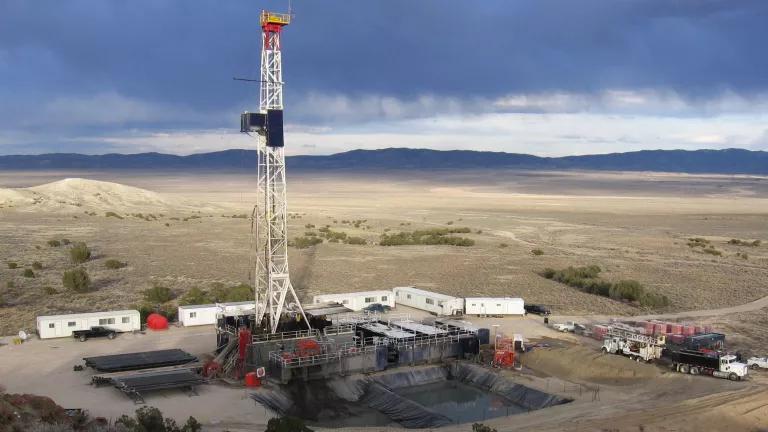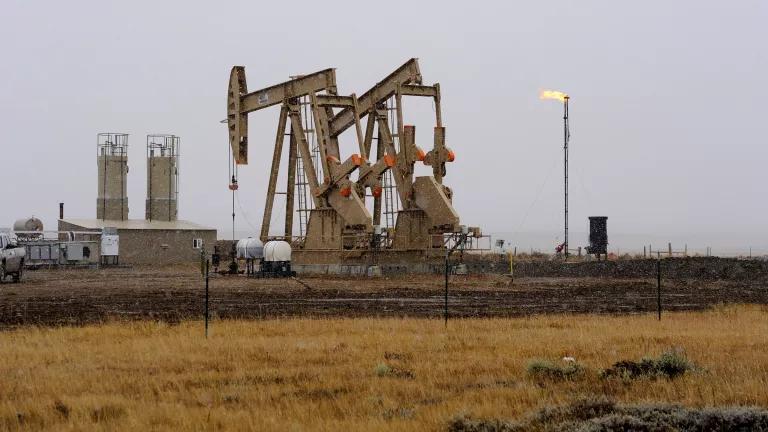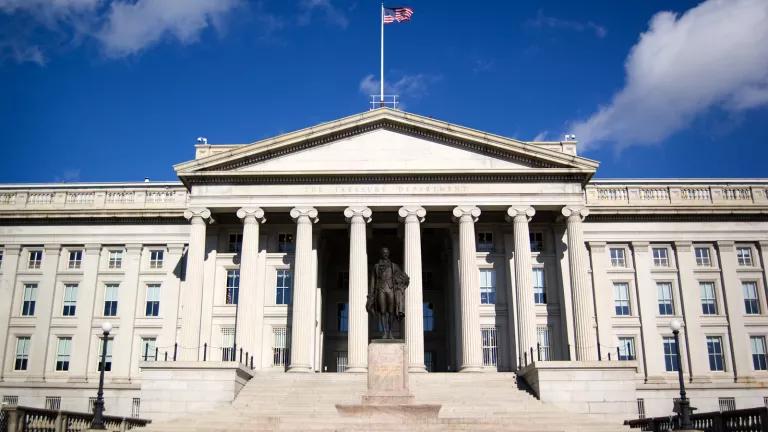Interior Reveals Long-Awaited Oil and Gas Reform Proposal
The Bureau of Land Management has unveiled its update to the federal onshore oil and gas program regulations advancing a suite of long-needed reforms.

An oil and gas drilling rig near Railroad Valley, Nevada
Bureau of Land Management
In a long-expected announcement today, the Department of the Interior's Bureau of Land Management revealed a proposed suite of important reforms to the onshore oil and gas program that formalize measures in the Inflation Reduction Act (IRA), ensure greater industry liability for cleaning up drilling sites, and limit leasing in areas with minimal development potential. The proposed changes follow decades of recommendations for reform from the Government Accountability Office (GAO) and Interior’s own internal review completed in November 2021.
In substance, many of the proposed rule’s changes map to the fiscal measures in 2022’s IRA. That law advanced several reforms aimed at improving taxpayer returns for the exploitation of publicly owned oil and gas resources. Specifically, the proposed rule clarifies the Bureau of Land Management's approach to implementing the following IRA provisions that:
- Increased royalty rates on federal onshore leases from 12.5 percent to at least 16.67 percent over the next 10 years, with royalties on reinstated leases rising to 20 percent. The proposed rule invites comment on further increases beyond the IRA’s 10-year horizon, but for now proposes keeping these rates steady into the future.
- Increased minimum bids—or the amount companies must offer per acre during lease sales—from $2/acre to at least $10/acre for the next 10 years.
- Increased rental rates for federal onshore leases from $1.50/acre to $3/acre. After two years, rents rise to $5/acre and at least $15/acre from year nine and onward. For reinstated leases, the rental rate is $20/acre. Following the sunset of the IRA in 2032, the proposed rule would tie both minimum bid and rental rate increases to inflation, ensuring that public lands do not become bargain basement areas for oil and gas development as has been the case for several decades.
- Imposed an “expression of interest” fee of $5/acre on companies looking to nominate acres for lease at a future lease sale.
- Ended non-competitive leasing, which allowed companies to anonymously procure leases at cut rate prices. History has shown that while this type of leasing expanded the footprint of leasing, it rarely resulted in development and represented an unnecessary strain on Bureau of Land Management resources.
Beyond the basic fiscal reforms above, the proposed rule also advances three crucial and welcomed reforms:
- Significantly increased bonding rates that will expand industry’s financial responsibility to clean up oil and gas wells following the end of production. Specifically, the proposed rule would raise per-lease bonding amounts from $10,000 to $150,000, and statewide bonding from $25,000 to $500,000. In addition, the rule would end the problematic practice of nationwide bonding, that allowed industry to cover all its liabilities nationwide with bonds that were woefully insufficient to ensure cleanup. This represents a major advance in an area in dire need of reform. Under current bonding levels, the GAO has found that the Bureau of Land Management held just over $2,100 per well in bonds in 2018, despite the cost of well plugging and remediation typically falling between $25,000 to $100,000-plus. In addition, the Bureau of Land Management is requesting comment on whether the rule should allow for inflation-based adjustments to these rates to better reflect rising costs of plugging and remediating wells.
- Builds on the end of non-competitive leasing by stopping the leasing of “low-potential lands,” which are areas that can technically be offered for lease but have little chance of ever being developed. Leasing of low-potential lands has represented a major area of waste for the Bureau of Land Management, leading to the expenditure of scant staff resources and the locking up of lands that could otherwise be put to an alternative beneficial use.
- Developers will no longer be allowed to receive a two-year extension for approved applications to drill. In the current system, drillers can stockpile drilling permits by extending their existing approvals to drill out for four years. The new language sets a definitive three-year timetable for these permits to expire unless developers begin work on their leases. In addition to addressing issues with stockpiling, the Bureau of Land Management has proposed this significant change to lower administrative costs and therefore the burden on taxpayers.
Following the historic changes contained in the IRA, in concert with these two additional reforms, today’s onshore oil and gas rule comes nearly 40 years after the last revision of these regulations. To put it mildly, these changes were badly needed and will go a long way toward expanding taxpayer fairness, increasing industry’s liability for its harms, and right sizing the leasing footprint to areas with the most viable oil and gas resources.
We are also appreciative that the Bureau of Land Management is considering in the proposed rule’s preamble how the land management agency could begin to systematically account and manage for the considerable emissions associated with the permitting of oil and gas. This is particularly critical given that nearly a quarter of the nation’s greenhouse emissions are tied to fossil fuel production on federal lands and waters. There are numerous authorities and avenues available to the agency to begin limiting the federal oil and gas program’s contributions to climate change. Doing so could go a long way toward closing the remaining emissions gap left by the IRA’s significant climate investments, while also paving the way to transition oil and gas dependent economies to a more diverse and resilient economic future. We hope, as the agency reviews comments, that it seriously considers recommendations for how to achieve these outcomes and lays the groundwork for a more comprehensive approach to managing the oil and gas program’s climate impacts.





